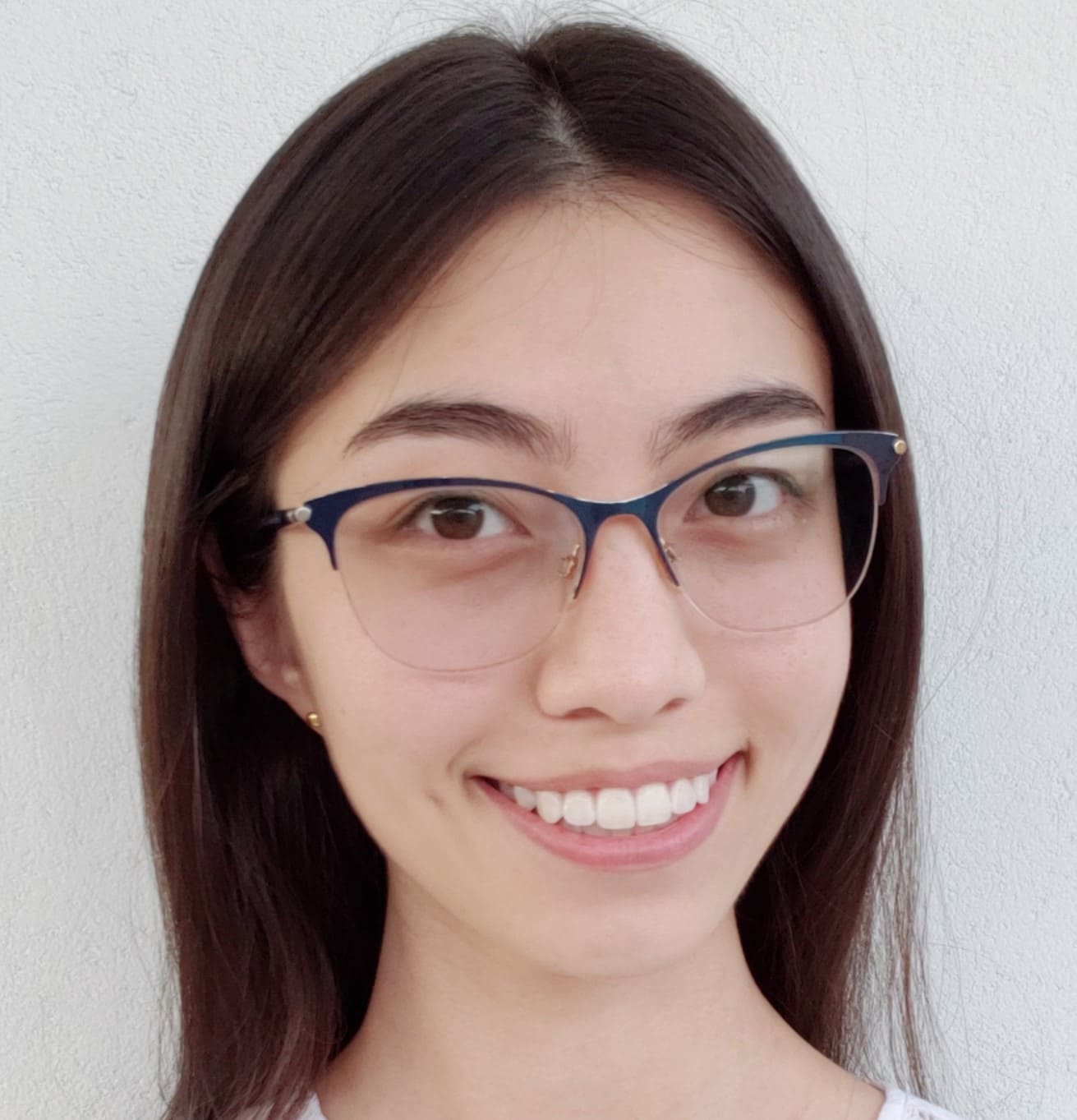ORIGINAL ARTICLE
MATSUO, Melanie Ieko [1], PETRONCARE, Fernanda [2], GARCIA, Marianna Cristina [3], BEZERRA, Juliana da Silva [4]
MATSUO, Melanie Ieko. et al. Learning disabilities and RPG as a mediator of learning. Revista Científica Multidisciplinar Núcleo do Conhecimento. Year 06, Ed. 05, Vol. 15, pp. 135-155. May 2021. ISSN: 2448-0959, Access link: https://www.nucleodoconhecimento.com.br/education/rpg-as-a-mediator
ABSTRACT
This article, with a qualitative approach and applied nature, with exploratory objectives, is a case study where the RPG was applied as a way to aid learning. The research focuses on the use of playfulness and the benefit of group work as pedagogical tools for teaching interventions, especially for those with learning difficulties. After the closure of the activities, it was concluded, through the results obtained, that, when working in a playful way, the barriers that students encounter can be reduced, expanding personal and social development, thus making children have better performance in school.
Keywords: Learning difficulties, Ludic, RPG, Intervention activities.
INTRODUCTION
Learning is a much longer and more complex process than is usually observed in everyday life. It involves new knowledge, which can be absorbed anywhere, and knowledge that has already been acquired in the past.
[…] é o que nós chamamos de zona de desenvolvimento proximal. Ela é a distância entre o nível de desenvolvimento real, que se costuma determinar através de solução independente de problemas, e o nível de desenvolvimento potencial, determinado através da solução de problemas sob orientação de um adulto ou em colaboração com companheiros mais capazes (VIGOTSKI, 1998, p. 112).
According to the Montessori method, we are susceptible to learning at any time in our life. The individual, in contact with the environment, interacts with what causes him curiosity (MONTESSORI, 1949).
Therefore, it should provide situations in which the child feels free and comfortable so that his interests are awakened in learning, because he learns what he wants and with whom he likes.
Many difficulties occur through the demotivation felt in the non-understanding of the contents, because the subjects are often transmitted still in a traditional and regulated way, thus causing the student to lose interest in learning.
It is understood that the literate individual is the one who has, in addition to the understanding of letters and numbers, the ability to reflect and interpret everything around him, establishing relations with the environment that is inserted. Reading and writing are part of our environment. We are surrounded by information and so it is important to have knowledge of reading and writing. It helps us develop capabilities, have autonomy, and have connections to what we like.
Therefore, we must appropriate the environment that the student is inserted, use different methods and have a differentiated range of materials so that the student’s interest is aroused. Recognition is the best way to stimulate someone (verbal information)[5].
In this sense, there are children who cannot follow this learning process, and there may be cases of extrinsic or intrinsic difficulties in the areas of reading, writing, problem solving, among others. Difficulties in reading, changing letters, misinterpretation and other cases are configured as difficulties in the mother tongue and must be carefully observed so that, thus, the cause and solution of the problem can be found.
In view of all the aspects mentioned above, the research, methodologically, has a qualitative approach of applied nature, with exploratory objectives, being a case study.
THEORETICAL FOUNDATION
CHAPTER I: LEARNING DIFFICULTIES
In our daily lives, we are often faced with some difficulty in our mother tongue, whether it is in reading an advertisement that is on the street or in the interpretation of a news item that is in the newspaper. But why is this?
It is understood that the mother tongue is the one we learn first. It is through it that babies give the first signs of communication, expressing their desires and their feelings. Its learning is done through the contact that the child has with the environment in which he lives being it diversified, because there are several means of learning.
It is in school that children have a greater contact with this vast world of knowledge. They go through a process in which they constantly construct and reconstruct meanings.
O processo para uma aprendizagem eficaz depende de inúmeros fatores, dentre os quais, os mais prementes são: o talento do professor, o tipo intelectual do aluno, as oportunidades oferecidas pelo ambiente imediato da escola, perspectivas futuras de vida do aluno. (MOTA; PEREIRA, 2002, p. 2).
However, we may face several difficulties during this process, which may be writing, reading, interpretation, problem solving among others. Thus, learning difficulties are understood as a series of problems that occur due to biological or external factors to the individual.
“The biological factors that contribute to learning disabilities can be divided into four general categories: brain injury, errors in brain development, neurochemical imbalances, and heredity.” (SMITH, C; STRICK, L, 2012, p. 20). Regarding the factors external to the individual, it is important to understand the school and home environments in which children live. They are determinant in the development of individuals, because they can cause both an improvement and a setback in the framework of the difficulties that the student presents (SMITH; STRICK, 2012).
Despite the increase in interest and research on the subject, there is still no definitive solution to such a problem. However, the community, the family and the school can collaborate so that this issue does not worsen more and more in the people affected.
To intervene in these difficulties, the best option is to use the playful, because the child will have greater interest in the subjects and greater development in the activities. “Play leads the child to become more flexible and to seek alternatives for action. While playing, the child focuses his attention on the activity itself and not on results and effects.” (KISHIMOTO, 1999, p. 64).
The games should be made so that they have a goal to be achieved. Otherwise, they are no longer an essential pedagogical tool and will become just fun for the child.
Many teachers use the playful as a pedagogical tool for better learning and to arouse the interest of students. “In elaborating his theory of the law of internal connection, he realizes that the game results in intellectual, moral and physical benefits and erects it as an important element in the integral development of the child” (HUGHES, 1925, p. 41).
We learned from Wallon that childish is synonymous with playful, that is, all the activity of the child is playful. According to Gilles Brougère, play is not an internal dynamic of the individual, but an activity endowed with a precise social meaning that, like the others, needs learning.
It is necessary to dissolve the play of a simple recreation activity, because the play is not just about fun. “Playing presupposes at first that in the set of human activities, some are repertoirized and designated as ‘playing’ from a process of complex designation and interpretation.” (BROUGÈRE, 1998, p. 20). It is the duty of the educator to appropriate this universe, and bring play as a pedagogical tool.
Froebel (1912) was the first to place the game as a tool of pedagogical work, with the creation of kindergarten, where he separated the functions of games as gifts and toys and games. In the gifts there were materials such as the ball and the cube, while in the toys and games were the symbolic activities. He saw the child’s ability to create meaning from objects around him. “Play and talk are the elements by which the child lives.” (Froebel, 1912, p.54).
When we appropriate play for the development of a child with learning difficulties we get better results, since the child relates to this type of activity in an intense way. “The game is also a form of socialization that prepares the child to occupy a place in adult society” (BROUGÈRE, 1986).
Starting from the Montessori method, play is the child’s work. It is through play that the child develops the social, physical and psychological aspects and creates his independence.
Applying the difficulties that she presents in the form of a game, it is possible that, when playing, she learns and makes the association with what is passed during the classes.
The importance of play as a pedagogical tool was already said by Plato in 1948 in The Laws. It was also said by Aristotle in Nicomachean Ethics in 1983. Therefore, this article proposes the use of the Role Playing Game (RPG) as a tool for playful intervention activities.
CHAPTER II: RPG AND ITS RELATIONSHIP TO LEARNING
Created in the 70’s in the USA, the RPG is an interpretation game that develops the imagination. Played with several people, it is an activity where everyone creates their characters and a single story. It arrived in Brazil around the 90s, being little explored as a didactic resource.
The RPG is a little used resource, but it is a very interesting tool, where it is possible to arouse the interest of students and work on various subjects in groups.
The child needs to play. She has the right to play. It is through play that she understands the world, creates the ability to organize, understands rules and develops imagination. Play is the most natural and fun way to acquire knowledge. “The game, by taking place in situations without pressure, in an atmosphere of familiarity, emotional security and absence of tension or danger, provides conditions for learning.” (KISHIMOTO, 1998, p. 140).
However, even though the importance of play is highlighted these days, few use the RPG. There are few theoretical materials where the RPG is used as a learning tool. In many articles, RPG is applied to high school students.
One of the only rules of the RPG is to have no rules, and it is possible that we make adaptations so that we can use it in a 3rd grade class of Elementary School I, for example. “The playful culture evidently comprises game structures that are not limited to those of games with rules” (BROUGÈRE, 1998, p. 24).
The proposal of using the RPG as a pedagogical tool for children with learning disabilities is to bring the benefits of play so that the child learns and feels ownership of his own story. The proposal is to remove the child from the standardized way of learning and make him use imagination, memory, group interaction and reasoning so that, thus, he can learn and dissipate his difficulties. “When playing, the child is not only situated in the present moment; but also in its past and its future. Playing, as a therapeutic activity, enables the child to overcome the traumatic situation.” (MRECH, 1998, p. 162).
We have a rich learning tool in our hands, which in addition to demonstrating positive results in teaching, arouses the interest of students, thus facilitating the learning process and making it more interactive and fun. “The educator can play an important role in the course of the games if he can discern the moments in which he must only observe, in which he must intervene in the coordination of the game, or in which he must integrate himself as a participant in them” (OLIVEIRA, 1992, p. 102).
In addition to playing, it is important to highlight the importance of classmates. Group work is an instrument of social insertion and coexistence in community. It promotes participation of children among themselves who feel more comfortable interacting with their peers.
Piaget (1993) emphasizes the importance of developing the technique of work by groups, when reporting the importance that educators began to attribute to social life in class, and focused his studies on psychological factors related to the child.
The child is not a passive being. This statement is in line with what prevails today when the school and its methodologies privilege, for example, playful methods, interactivity and group work itself for the fixation of concepts, intellectual growth and even citizen development of the child. These new methods come at the expense of the concept by which teachers spoke and students listened, absorbing the knowledge of their masters.
At this point, still following the line of Piaget (1993), three observations are very important:
- The difficulties of some masters in making and understanding;
- Rational thought is not innate;
- Reason and its social element of cooperation.
In general, it is understood on the first point that children often interact well with each other and understand in a simplistic way part of the disciplines that they had not understood in the explanation of their teachers, who often do not realize that the problem may be in their explanation or didactics and end up judging the student, without seeking before a solution to the case that may be/be in the explanation of a colleague.
In the second point, we can refer to the question of logic and the child’s own capacity for understanding, which are not deterministic; thus, as a team, students can feel freer to practice their own opinions, without the “presence of the master”, which in turn can cause an authoritarian impression and as the only source of knowledge on the subjects, thus generating total discomfort, which often harms the student in his freedom of thought and on the search for his identity and ability.
Finally, in the third point, it is understood that cooperation is necessarily part of community life – in this case the school community – and helps in rational and even emotional development. As already mentioned above, in a group the child does not feel total pressure, because they are their daily companions. The conversation is spontaneous and simplistic, making the exchange of ideas respected and discussed by all, so that they can solve the problems in an independent and concrete way.
Thus, the dynamics that the RPG provides reinforces the effectiveness of group work, which, in education, promotes the interaction of students who are guided by teachers in favor of learning a certain subject. When students work together they learn from each other organically, making teamwork collaborative.
Vygotsky is one of the most studied authors when it comes to collaborative work in the school environment. For him “the construction of knowledge implies a shared action requiring cooperation in exchange for mutual information, with consequent expansion of individual capacities” (Vygotsky, 1989).
The author has always worked in the defense that students, as subjects, as well as their learning – what he called intrapsychological processes – always result from the relationship with other people – the so-called interpsychological processes – the relationship between these processes that are formed when teamwork produces referential models for children.
In short, the RPG, as a way of playing, should be seen as an important tool for teaching the contents and also for the aid in learning difficulties, because, thus, children understand our world in a significant way. With this instrument, they can, in addition to acquiring new knowledge and solve their doubts, put into practice what they already understand in an interactive and playful way.
PATHS OF PEDAGOGICAL INTERVENTION
The research was conducted with a student of Elementary School I. At first, the child’s entire routine was observed, where it was possible to perceive that she presents dispersion during the teacher’s explanations. Despite this, the student understands what the educator says when she is concentrated.
The child presented difficulties during the execution of the activities during the day. Within the proposals, she should make a textual production in a group, where it was possible to notice that the student felt a little uncomfortable, because she could not keep up with her colleagues. After class, we talked to the teacher, who reported everything about the child’s classroom performance and their participation in it.
Thinking about the reality seen, we made a proposal, in the second moment, where the child should write a report about his vacation. Soon after, we asked her to read and comment on the text produced. During the execution of the activity, the student dispersed a few times, but quickly refocused. In addition, he had difficulties in reading and writing some words, but performed very well when he commented on his vacation.
By observing the text, it was possible to see that some words are misspelled. For the most part, the letters are exchanged, probably because their pronunciations are similar. Examples:
Table 1 – Examples of letter exchanges
| Correct spelling | Student’s spelling |
| Ball | Pall |
| Beach | Peach |
Source: authors of the article.
Taking into account all the above facts, it was concluded that the child presents difficulties in the mother tongue. We think about the intervention activities with the objective of using the playful to assist the student in her development. For this, we created an adapted role-playing game composed of eight stages where the child can build his own story with the help of the applicators. Each phase has a different mission (activity). If the mission is completed, she gains the power to bring a companion (friend) to the game. Each applicator has a different function: master (narrator), genius (applicator who will have three “magic cards” with tips for the completion of the mission) and villain (applicator of the activities, and in the end will be defeated by the completion of them).
We went to the child’s house, with the permission of the parents, so that the activities could be applied with the student. The choice of environment was important, as it helped in the concentration and comfort of the child.
On the third date, we talked to the student to try to calm her down and make her comfortable. In addition, we explained how the game would work where it reacted positively. We started developing the story, where the child told her she was a superhero. His first mission (activity) was to save the animals. For this, we provide images of animals, on plasticized paper cards, with their respective names, separated by syllables and scrambled.
The objectives of this activity were to enable the child to organize the words correctly and relate them to their respective images, thus, knowing the right names of the animals, stimulate reading and reasoning.
During the activity, the student had difficulties in reading some syllables and, consequently, in their organization. However, after a short period, she was able to perform the activity simply and quickly. As expected, the child exchanged some letters. For example, in giraffe, the student read “rotated”, but with the necessary interventions, she understood her mistake and corrected it immediately.
Figure 1 – Material from the First Mission
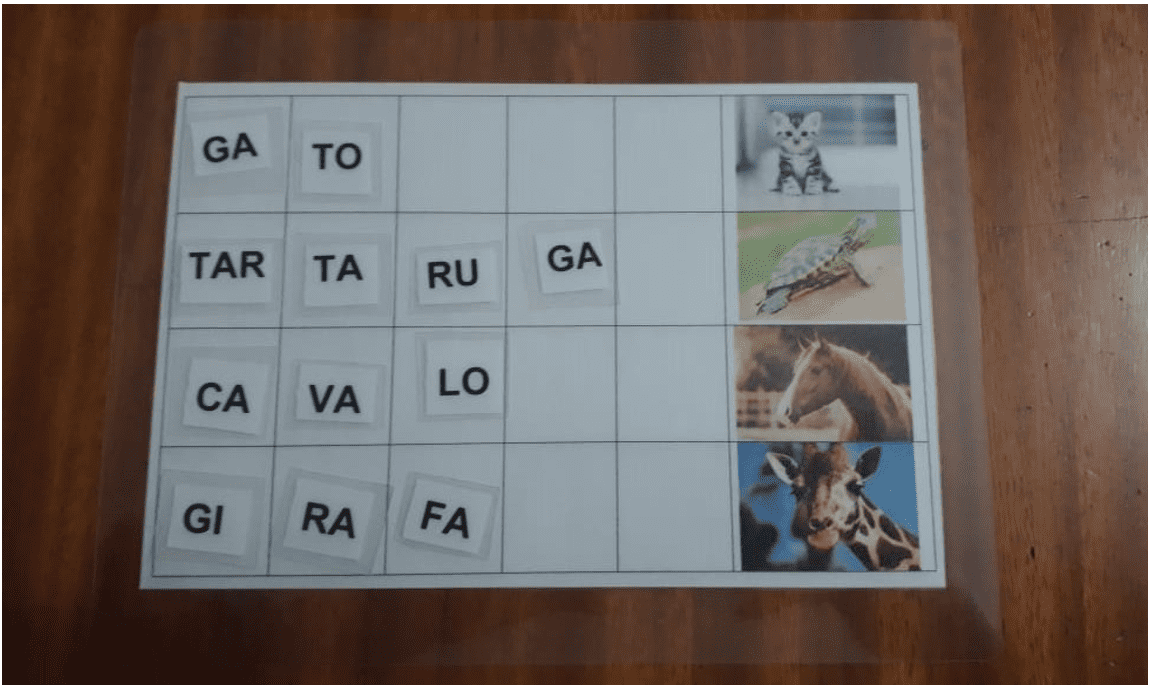
In the fourth meeting, the child was able to invite a classmate to participate in the game, since he was successful in the previous activity. We proposed, for the second mission, for the student to save her city. For this, she must, together with her companion, complete a memory game where an image was related to her respective name.
The objectives of this activity were to stimulate reading, reasoning and teamwork.
During the activity, the student, again, had difficulties in reading some words, such as “badaria – padaria” (bakery) and “brédio – prédio” (building), because they are letters that she usually exchanges. Despite this, the child could perceive the differences between the mistake made and the correct way of reading the words. In addition, she made the relationships right and the game was completed.
Figure 2 – Second Mission Material
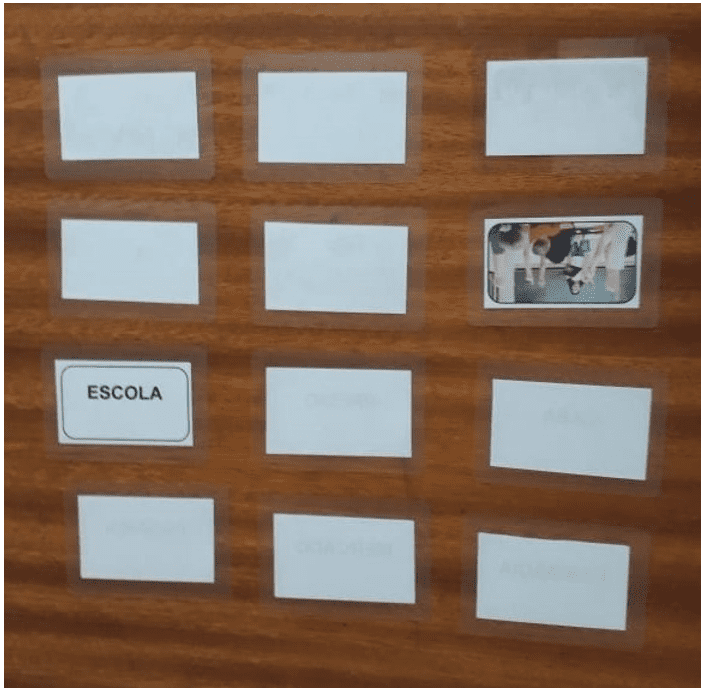
In the fifth meeting, the student was able to invite two classmates, as she successfully completed the previous activities. To follow the game, the student should reduce the garbage of the city she lives. For this, five recyclable garbage cans were made, identified only by name, being plastic, paper, metal, glass and organic. The child should throw the garbage provided in the corresponding cans, with the help of his companions.
Figure 3 – Material from the Third Mission
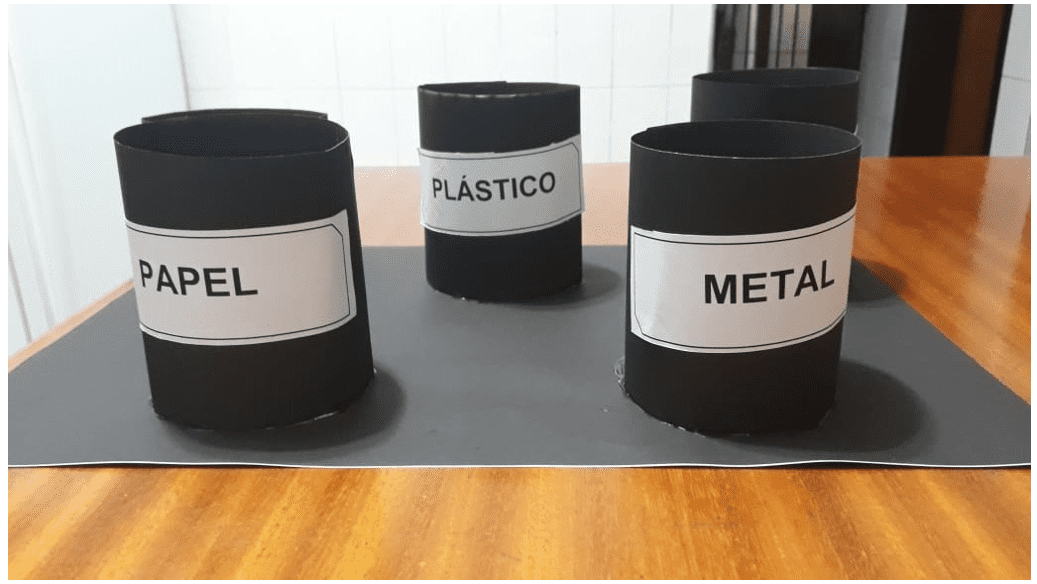
The objectives of this activity were to stimulate reading, reasoning and teamwork.
During the activity, the student did not present any difficulty when reading or relating the objects to the cans. In addition, the interaction between the children took place so that everyone could have fun. With the conclusion of the game, colors were added to the cans. This represented the success of the child, who could help reduce the garbage of the place where he lives, and so the city gained colors.
Figure 4 – Material from the Third Mission after the city is saved
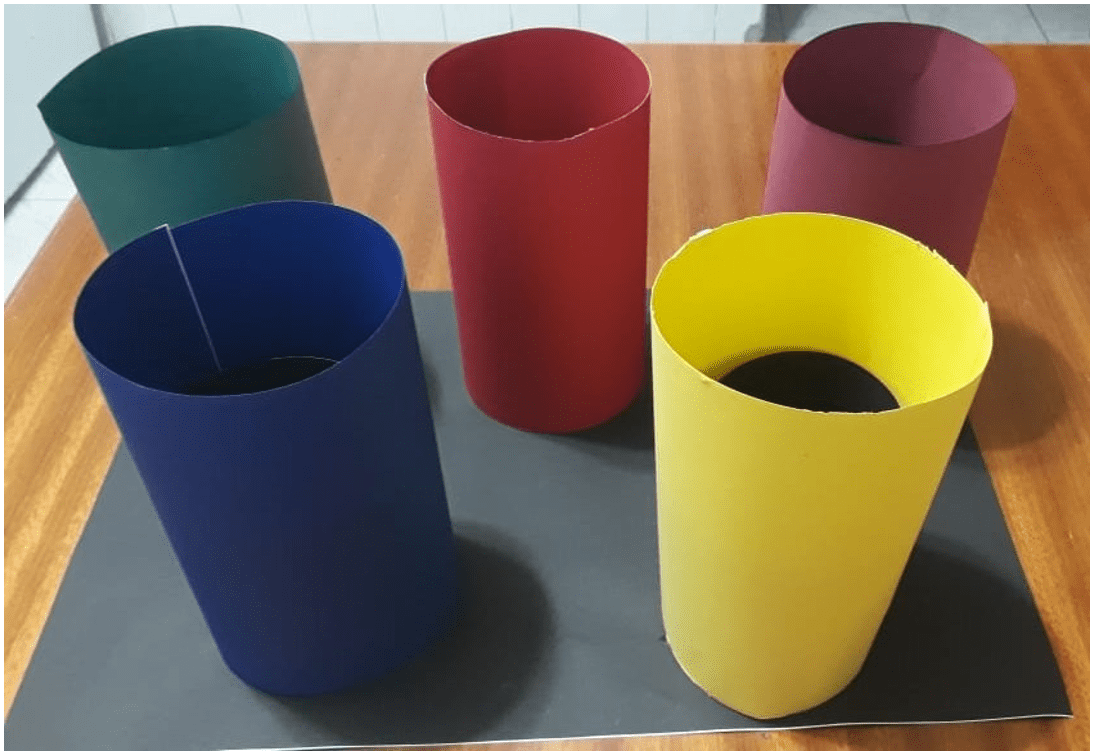
At the sixth meeting, the student was able to invite three classmates. For this mission, we brought the Harry Potter movie as a theme, in which the child likes a lot. Within this universe, there is a wizarding castle, called Hogwarts, where children and young people participate in various classes to learn all about magic and control their powers. However, they are all divided into what are called houses. At Hogwarts, there are four of them: Gryffindor, Slytherin, Ravenclaw, and Hufflepuff. The students of each house compete in the so-called House Cup, where, for this, they must earn points in several ways: behavior, performance in classes among other ways.
As quatro casas chamam-se Grifinória, Lufa-Lufa, Corvinal e Sonserina. Cada casa tem sua história honrosa e cada uma produziu bruxas e bruxos extraordinários. Enquanto estiverem em Hogwarts os seus acertos renderão pontos para sua casa, enquanto os erros a farão perder. No fim do ano, a casa com o maior número de pontos receberá a taça da casa, uma grande honra. (ROWLING, 2015, p. 86 e 87).
For this reason, we set up an activity where the student had to help her home (Gryffindor) win the House Cup. She should answer questions regarding the Portuguese Language. By getting the questions right, the child gained pieces of a puzzle that, when assembled, would form the image of the house to which it belongs.
Figure 5 – Puzzle, made with ice cream sticks, assembled
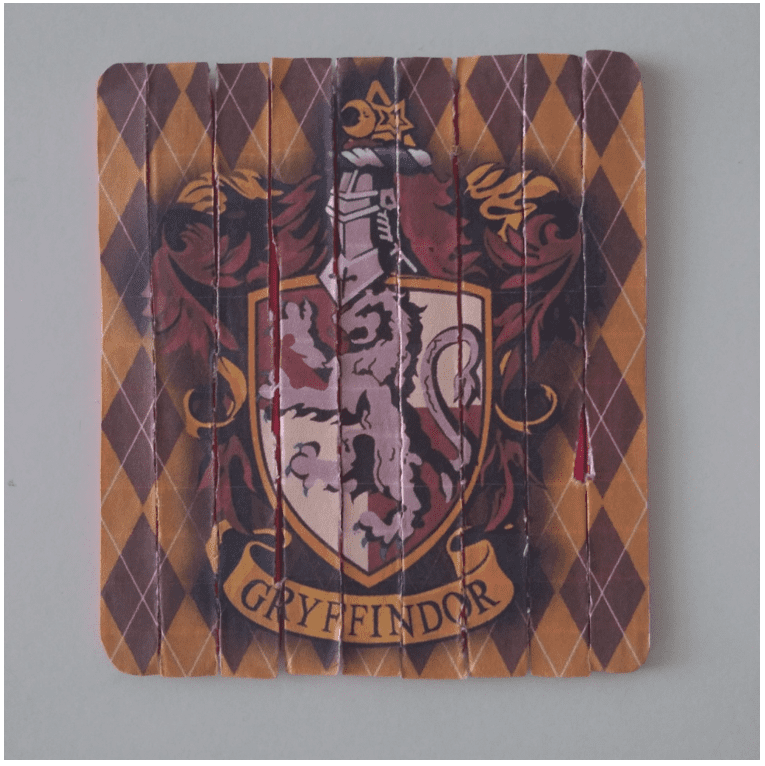
The objectives of this activity were to stimulate reading and reasoning.
During the activity, the student was very happy to learn that her favorite film was part of her story. For this reason, she felt very motivated to do the activity with her colleagues. Each colleague represented a different opposing house. The student showed difficulties to conclude the game, because the words presented in the answers were purposely placed in similar ways, working one of the greatest difficulties of the child, which is the exchange of letters. She used two tips to complete the activity.
At the seventh meeting, the child’s mission was to fight caries. We delivered to the student images of products for oral hygiene and those that cause caries where she should relate them correctly.
The objectives of the activity were to develop improvement in the reading and interpretation of text, so that she could relate the text to the image.
The student presented some difficulties during reading, such as, for example, difficulties in reading the word “bacteria”, but interpreted and related the images correctly.
Figure 6 – Material of the Fifth Mission
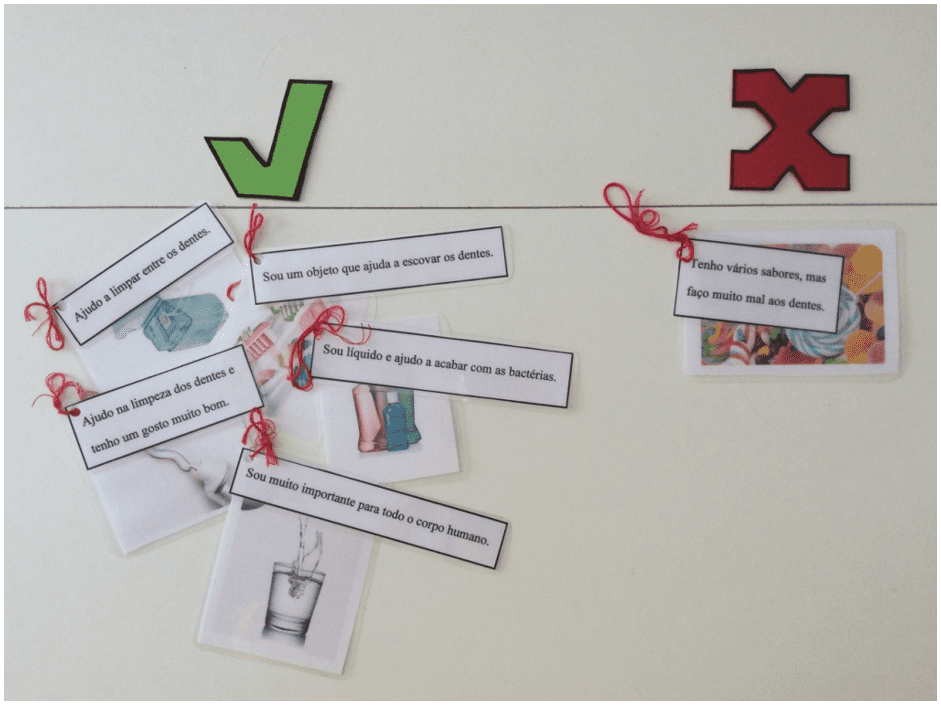
In the eighth meeting, the student had to brighten the world through music. The proposed activity had cans, which contained excerpts of the child’s favorite music. She should throw a ball and try to hit it into the can. If he got it right, he would win the piece of music that was inside the can, otherwise he would have to complete without having the same. After getting the parts of the song, the child should unscramble them and try to get the name of the song right, which in this case was “If this street were mine”, interpreted by Quintal da Cultura.
Figure 7 – Material from the Sixth Mission
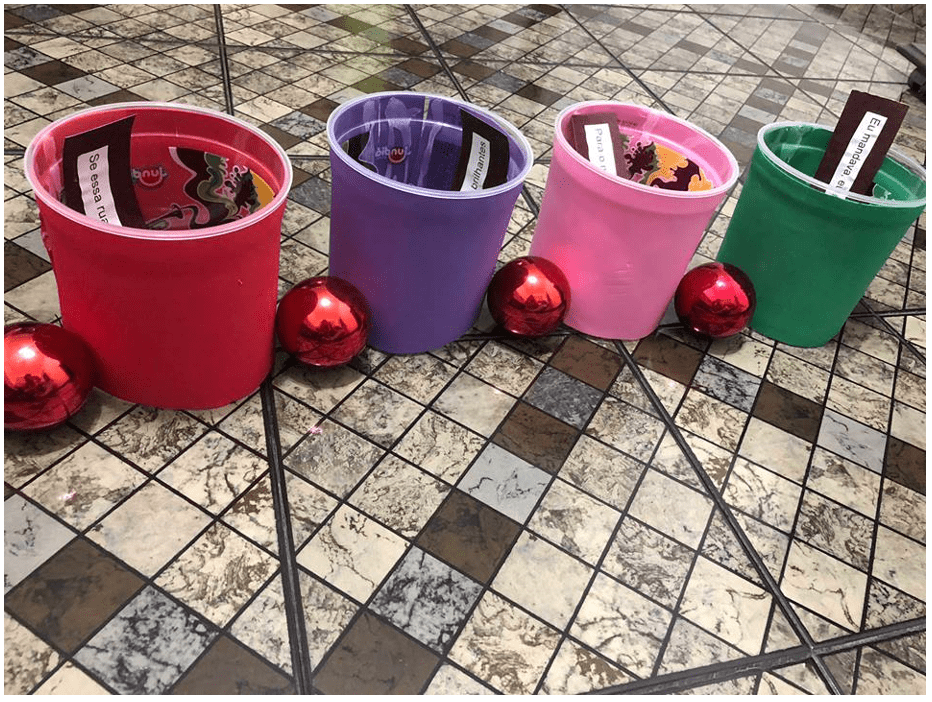
The objectives of this activity were to appropriate motor coordination, work on reasoning, work on memory and develop reading and writing.
The child hit a can of four, possessing the phrase “For mine, for my love to pass.” First, she tried to sing this passage in various rhythms to see if it had worked. Soon after, he tried to think of words that could fit the music, but it didn’t work. The child decided to ask for a tip. It was given the name of the musical group.
After the tip, the student realized that it was her favorite song. She put the passage in its correct position, but had to write the other excerpts, which in this case were “If this street, if this street was mine”, “I commanded, I ordered to tile” and “With pebbles, with pebbles of brilliant”, because she had not conquered them previously. The child showed no difficulty in writing with the exception of the word “tile,” which he wrote incorrectly. After the applicator’s explanation of the spelling error, the child rewrote the word correctly.
In the ninth meeting, we propose for the student to save the citizens of her city, who were represented by the friends participating in the game. The activity consisted of bursting bladders that bore the name of their colleagues. Inside each one, there was a paper written something that a certain person likes, whether or not it was from the same person on which the name was written on the balloon. The child had to write and relate each name to what she found inside the bladder.
The objectives of this activity were to provide group interaction, the practice of writing and the encouragement of reading.
Figure 6 – Material of the Seventh Mission
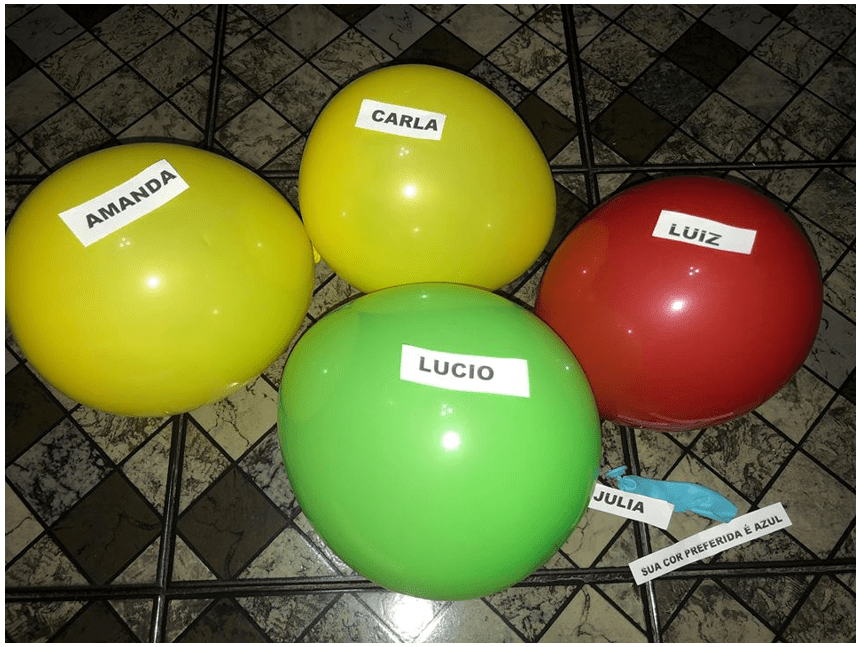
The child showed doubts when relating the person to the object. This provided fun for all the friends who were together with her, creating an environment where everyone could get to know each other better. The child correctly wrote the names of the classmates, but showed difficulty in writing the name of some objects. Therefore, the friends present encouraged her and tried to bring back memories of her classes. Consequently, the student was able to write the words correctly, causing everyone to celebrate the completion of the activity.
In the last encounter, the child was supposed to save other superheroes through a “treasure hunt”, where we propose for him to follow tips that were hidden in his house to find his favorite superheroes.
The objective of this activity was to stimulate the child’s reading and stimulate the correct spelling of words, always using playfulness as a fundamental tool.
Figure 7 – Material from the Eighth Mission
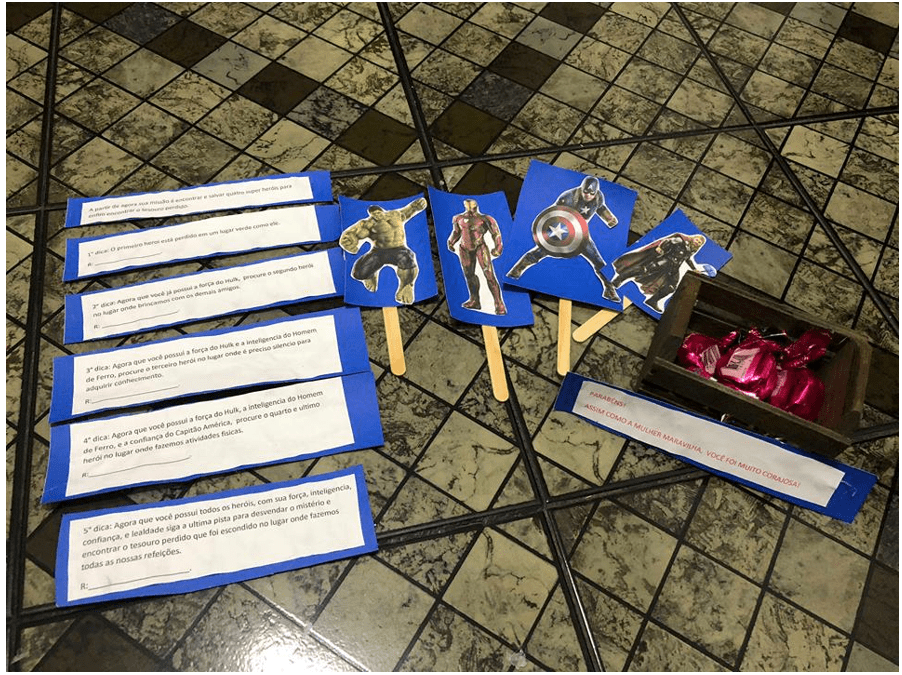
The student did not present difficulties in performing this activity, but she pointed out that some of the words identified were written incorrectly by herself. She noticed the correct spelling of the word “última” (last), on which she wrote “utima”, and the word “tesouro” (treasure), on which she wrote with the letter Z, and stated that after the game she would no longer have these difficulties.
Finally, the child completed the activities and also his story. It was asked that the prank be held once again. Everyone was able to play and have fun, highlighting the positive results of learning by playing and group interaction.
FINAL CONSIDERATIONS
In view of the research carried out, it was possible to verify that learning difficulties can be caused by factors extrinsic to the individual, linked
.3kmj,to didactic and methodological issues. In this sense, we understand the need to apply interventions so that, thus, students do not face increasing barriers throughout their academic journey, such as difficulties in understanding texts and activities.
In the course of the meetings, we developed an adapted role-playing game, with the intention of working the difficulties presented by the researched student in a simple and easy way, but that still caused the interest in learning. Throughout the process, it was possible to perceive the breaking of many barriers, both in the learning difficulty and in the difficulty of group interaction. Because it is a game, the RPG brought security and comfort to the student, leaving her willing to perform each proposed activity. The learning process occurred naturally, since the child can learn by playing.
In Brazil, the use of RPG as a form of learning is little addressed. Therefore, one of the proposals of this article is to arouse the interest of educators in using it as a teaching tool. In addition, in order to help the child presented and demonstrate the importance of play, the activities performed had informal conversations in order to know the tastes, needs, facilities and difficulties of the same.
The student showed great interest in the most dynamic games, especially the one that involved her favorite film, and, consequently, greater ease to understand them, because she worked harder. On the other hand, in the less dynamic games, such as the one that addressed oral hygiene as a subject, the child felt less motivated and, therefore, presented more difficulties in their understanding.
For the most part, the results were positive. Through them, it was possible to see the benefits of playing in the learning process and, especially, of the RPG, because it is a game where players create their own story, and can be used in various ways and work different themes.
Thus, the student, from the interventions, produced more in the classes and presented improvements both in reading and writing, but still maintains some difficulties in relation to the exchange of words. It demonstrates more security when performing group work.
Even with some difficulties, the child sought different methods to correctly conclude all the challenges proposed to him and interacted spontaneously in a group, thus concluding that he was able to develop throughout the work, achieving the objectives proposed in this article, which were: to assist the child researched and demonstrate the importance of the playful so that, thus, it is not harmed in future daily activities, such as the simple reading of an advertisement.
With the conclusion of this article, it was observed that children demonstrate greater and better results when they work in a playful and team way. Therefore, we propose that schools expand their methodology by giving space to these activities.
As stated earlier, the RPG is little used as a pedagogical tool. For this reason, we propose the use of this game as a way to demonstrate that different means can be used to help school students to be interested in classes and thus be able to learn more.
The teacher has an important role in the lives of the children they meet during their lives. Therefore, they should not be afraid to explore new worlds or new ways of working. The RPG is an example that you can adapt something complex to help teaching, but it is not the only way to go. There is a vast world that has yet to be explored.
Finally, it is important to emphasize that the use of the playful is not the solution to all problems, but it is an efficient way to work in the classroom. Students with learning disabilities demonstrate a greater willingness and motivation to perform playful activities, which previously seemed “boring” and “bland”. In addition, he presents a greater understanding of the contents when they are shown playfully, because the child learns what makes sense and that pleases him.
REFERENCES
BROUGÈRE, G. Brinquedo e cultura. São Paulo: Cortez, 2010.
CORTELLA, M. S. Palestra: Um jeito simples e fácil. São José dos Campos. Agosto de 2016.
KISHIMOTO, T. M. Jogo, brinquedo, brincadeira e educação. São Paulo: Cortez, 1999.
KISHIMOTO, T. M (Org.). O brincar e suas teorias. São Paulo: Cengage Learning, 2014.
MONTESSORI, M. T. A. Mente Absorvente. Rio de Janeiro: Editora Nórdica, 1949.
MOTA, M. S. G; PEREIRA, F. E. L. Desenvolvimento e Aprendizagem: Processo de construção do conhecimento e desenvolvimento mental do indivíduo. SETEC, 2002.
NETO, Antônio Alves de Oliveira; SANDRA, Aparecida Benite-Ribeiro. Um modelo de Role-Playing Game (RPG) para o ensino dos processos da digestão. Revista Eletrônica do Curso de Pedagogia do Campus Jataí. Vol. 2 – n. 13. 2012.
OLIVEIRA, Carla Mendes de; DIAS, Adiclecio Ferreira. A Criança e a Importância do Lúdico na Educação. Revista Científica Multidisciplinar Núcleo do Conhecimento. Ano 2, Vol. 13. P. 113-128 Janeiro de 2017.
PIAGET, J. O Trabalho por Equipes na Escola: bases psicológicas. Trad. Luiz G. Fleury. Revista de Educação. São Paulo: Diretoria do Ensino do Estado de São Paulo, 1993.
ROWLING, J. K. Harry Potter e a Pedra Filosofal. Trad. Lia Wyler. Rio de Janeiro: Rocco, 2015.
SMITH, C; STRICK, L. Dificuldades de Aprendizagem de A a Z: Guia Completo para Educadores e Pais. Porto Alegre: Editora Penso, 2012.
VYGOTSKY, L. S. Problemas de método. In: A formação social da mente. Tradução José Cipolla Neto, Luis S. M. Barreto, Solange, C. Afeche. 3. Ed. São Paulo Martins Fontes, 1989.
VIGOTSKI, L. S. (COLE, M; JOHN-STEINER, V; SCRIBNER, S; SOUBERMAN, E.). A formação social da mente: o desenvolvimento dos processos psicológicos superiores. São Paulo: Martins Fontes, 1998.
APPENDIX – FOOTNOTE REFERENCE
5. Information provided by Mario S. Cortella at the Lecture “A simple and easy way”, in São José dos Campos, in August 2016.
[1] Graduate of the Pedagogy Course.
[2] Graduated from the Pedagogy Course.
[3] Graduated from the Pedagogy Course.
[4] Advisor.
Submitted: October, 2020.
Approved: May, 2021.
